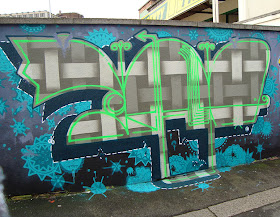Angelica Charlotte Pickles is a character voiced by Cheryl Chase in the Nickelodeon shows Rugrats and All Grown Up!, and is among the series' original characters. She is a spoiled brat and the cousin of Tommy and Dil Pickles.
Angelica's physical features and clothing on Rugrats were blonde hair with 2 pigtails (each punctuated with a large purple bow), an orange-and-black-striped shirt with flared cuffs, a purple dress, blue tights with green dots, orange socks,and purple sneakers. She is an only child — as a result, she has become a very spoiled child whose parents pander to her every need and give her anything she wants without cease. Her parents — Drew and Charlotte — are hardly ever around because of their jobs, which in turn may mean that her parents are neglectful; they also rarely punish or discipline her (the only time we see her being punished for doing something bad was in Runaway Angelica, where she gets a time-out in her room for breaking her father's fax machine after going into her father's study without his permission).
Being spoiled could also come from her parents' vast wealth, which is used to buy her toys and very expensive birthday parties. She whines and cries to get what she wants, and has a very whiny voice. Until Susie came along, Angelica was unique among the regular children in that she could properly talk to grown-ups, and as such, she acted nicely towards the adults, and was notoriously mean to the other babies especially by lying and distorting their view of the world; after Angelica says something crazy, a freak accident will occur and thus "confirm" her warnings. Despite this (or because of this), she became among the show's most popular characters. When Susie did come along, Angelica soon became a rival to Susie, and often competed in many things. In fact, almost every time Susie is in an episode, Angelica is also in it, although perhaps ironically, Susie's introduction episode did not feature Angelica. Interestingly, Angelica and Susie are the only characters who didn't appear in the two Rugrats pilot episodes.
She is two and a half at the beginning of the series, until In Angelica's Birthday, Angelica turns to a big three-year-old at the end. Despite acting mean to the babies most of the time, it is revealed in the 1995 season finale "Moving Away" that she was the reason Tommy, Chuckie, Phil and Lil befriended each other and, even more, that Angelica considered the other babies her best friends. Her first word and favorite food is cookies.
Angelica's parents, especially her mother, seem to also be spoiled. In Rugrats, Charlotte was Angelica's role model in some ways. Charlotte is the powerful boss of a major corporation. In a realistic dream sequence, she said that the only thing she liked better than corporate domination was corporate domination with her special girl. For Angelica's thirteenth birthday party, she hired an ice sculptor to sculpt Angelica out of the iceberg that sank the Titanic. She even suggested adding Angelica's face to Mount Rushmore for her sixteenth birthday. Drew is a little more responsible and reasonable with his daughter. He is often the one who worries about Angelica becoming too spoiled, but when he discusses this with Charlotte, she usually disagrees. Angelica's, as well as her parents', address is 53 Briar Tree Lane (stated in Rugrats episode "Stu Gets a Job." Stu mentions the address when he is calling to have Drew's Car towed).
She has a cat named Fluffy, most recently seen in the All Grown Up! ("AGU!") episode "Lucky 13" (first transmitted in the US: August 28, 2004). Also, since the beginning of the series, she was often seen with a doll named Cynthia, which she apparently considered her most prized possession.
When the series started, she, Tommy and Chuckie were their respective parents' only children. However, by the end of the series, Angelica was the only "only child" remaining, as Tommy gained a brother Dil through birth and Chuckie gained a stepsister Kimi through marriage. One episode late in the run focused on this fact ("Sister Act", first transmitted: January 26, 2001). Angelica came seventh in TV Guide's 50 greatest cartoon characters, above Bart & Lisa Simpson and Mickey Mouse, and she was the only Rugrats character to appear in the list.
In Rugrats in Paris: The Movie, when the babies control the robot Reptar, Angelica has many near-death incidents:
* When the babies crash into the balcony Angelica is on, she falls onto Reptar's nose, hanging on for dear life.
* As soon as the babies notice, Tommy presses a button that sends green gas out of the nose Angelica is on. She falls to the ground but the babies catch her in Reptar's hand. She squeals: "This isn't the parade I wanted!"
* Robo-Snail squirts purple goo at her.
* Lil opens a hatch and Kimi climbs up. As Angelica starts to, Robo-Snail grabs Reptar and Angelica falls but manages to grab a tooth. Reptar starts spinning around but poor Angelica manages to stay on.
* When Reptar boosts up the Eiffel Tower, he stops with a huge jolt at the top, sending a shrieking Angelica flying into the sky. She falls but is caught again. Angrily, she shouts: "What's the big idea? Are you potty-heads trying to get rid of me?"
* With Angelica in his other hand, Chuckie points at the Church his dad is at. Now he isn't holding onto the Tower, Reptar falls. He throws a screaming Angelica into the air and grabs the rail of the Tower. Angelica falls and lands on the head though. (Wikipedia)







































